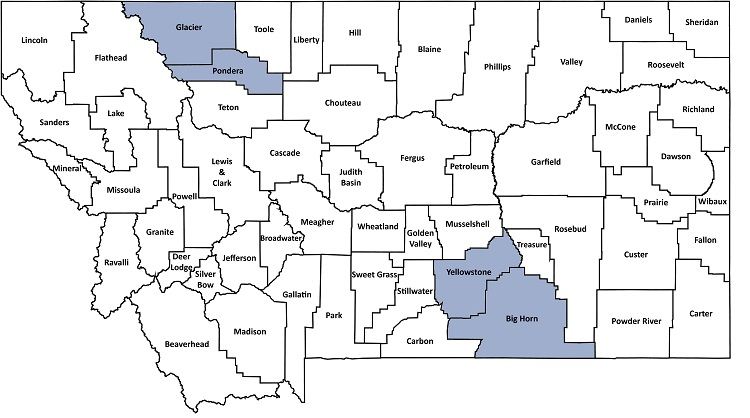
Here to serve the people of Montana and its livestock industry.
Animal Health Bureau
- Permits & Forms
- Brucellosis
- Brucella canis
- Feral Swine
- High Path Avian Influenza
- Johne's
- Rabies
- Trichomoniasis
- West Nile Virus
- National Poultry Improvement Program (NPIP)
- Pay for Permits Online
Helpful Links
Contact Information
Department of Livestock
Animal Health Bureau
PO Box 202001
Helena, MT 59620-2001
Email: livpermits@mt.gov
Bovine Trichomoniasis
In 2007 Montana implemented a trichomoniasis program based upon industry feedback. The primary focus of the program has been ongoing surveillance of Montana’s bull population through required testing.
Current Montana regulations require an official trich test for all non-virgin bulls that are:
- Moving out of any county designated as a trichomoniasis epizootic area (Big Horn, Glacier, Pondera or Yellowstone county).*
- Sold, loaned or leased within a trichomoniasis epizootic area.
- From multiple sources going to a common pasture for breeding.
- Imported into Montana.
- From herds adjacent or exposed to a confirmed positive herd.
*Bulls leaving the epizootic area for change of pasture only where adequate testing facilities are not available may complete testing within 45 days after movement.

All bulls must have official identification at the time the test sample is taken. This may be an official USDA tag (USDA 840 RFID tag) or a Montana trich tag. Montana trich tags are on a five-year color rotation, which changes on September 1st of each year.
- Sept 1, 2024 – Aug 31, 2025 Yellow
- Sept 1, 2025 – Aug 31, 2026 Green
- Sept 1, 2026 – Aug 31, 2027 White
- Sept 1, 2027 – Aug 31, 2028 Orange
- Sept 1, 2028 – Aug 31, 2029 Blue

Historical Test Data
Trichomoniasis Testing Data
The map below represents Montana trichomoniasis tests for FY25 (7/1/2024 - 6/30/2025) by county. Click the map to display the interactive map with more in-depth detail.
To view testing data for specific years, select a year below:
- 2024 Testing Data (map)
- 2023 Testing Data (map)
- 2022 Testing Data (map)
- 2020 Testing Data (map)
- 2019 Testing Data
- 2018 Testing Data
- 2017 Testing Data
- 2016 Testing Data
Disease Information
What is Trichomoniasis?
Trichomoniasis (trich) is a sexually transmitted disease of cattle caused by the parasitic protozoan, Tritrichomonas foetus. The resulting abortions and infertility associated with infection can be economically devastating to affected producers. Economic losses to the U.S. beef industry from reduced conception rates, lower weaning weights and increased culling are estimated to exceed $100 million annually. Trichomoniasis has worldwide distribution and is a major cause of infertility in naturally bred cattle in many countries.
- Three negative weekly cultures
- Single PCR
- Pooled PCR (Pooled testing is not accepted for positive, adjacent, or exposed herds.)
- Use of only virgin bulls or bulls less than 4 years old with an annual test.
- Define your breeding season; limit to 60-90 days if possible.
- Culling of open females.
- Allow only virgin heifers or pairs onto common grazing pastures, or cows that have been away from the bull more than 120 days.
- Know the disease status and herd health programs of all herds mixing with yours.
- Use your veterinarian to determine reproductive health of your herd, especially by pregnancy checking females and testing all bulls for trich and other reproductive diseases. Work with your veterinarian to develop a reproductive herd health plan.
- Avoid purchasing open or short bred cows (less than 120 days) to mix with your herd.
Additional Information
- Video: Testing for Tritrichomonas foetus
- Trichomoniasis Administrative Rules of Montana
- Bovine Trichomoniasis: Fact Sheet for Montana Cattle Producers
- Virgin Bull Statement
- Trich Quarantine Feedlot Application
Bovine trichomoniasis is a reportable disease within one business day to the State Veterinarian's office at 406/444-2976.
